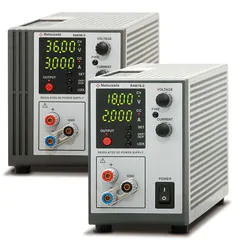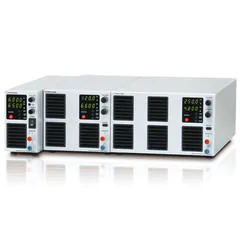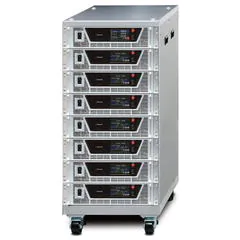Industrial manufacturing, inspection equipment, and testing systems rely on electronic circuits and communication protocols to control components like power supplies, measuring instruments, motors, and sensors. This control is typically managed either by a desktop computer (often running a Windows OS) or an industrial controller, such as a Programmable Logic Controller (PLC).
Historically, PLCs utilized serial communication protocols such as RS-485, CC-Link, and DeviceNet. However, with the widespread adoption of LAN technology, industrial communication methods have increasingly incorporated Ethernet, leading to the development of modern industrial networks.
In this issue, we will post our research on industrial Ethernet communications and other topics. The information presented is based on research conducted in Japan in April 2021. For the most current specifications and membership details, please refer to the official websites of the respective standards organizations.
| EtherNet/IP | Modbus | PROFINET | PROFIBUS | ||||
|---|---|---|---|---|---|---|---|
| Regular member | Associate Member | Regular member | Supporting member | ||||
| Membership fee | Admission fee | No fee | No fee | No fee | ¥150,000 | ¥0 | Membership costs are the same as for PROFINET. |
| Annual fee | $6000 | $2000 | 100,000 per unit | 10,000 yen (1 unit or more) | |||
| physical layer | Communication method | Cyclic communication, message communication | Master-slave system | Real-time communication and TCP/IP communication coexist | hybrid system | ||
| Physical Media | Ethernet, 10/100 BASE-T | No provisions | 100 BASE-TX option 100 BASE-T, etc. | RS485 | |||
| transmission speed | 10/100 Mbps | 100 Mbps | 9.6 kbps to 12 Mbps | ||||
| Communication distance | Within 100 meters between nodes | Within 100 meters | 100 to 1200 meters | ||||
| Topology | Star shape, line shape, ring shape, tree shape | Star shape, line shape, ring shape, tree shape | Bus type, ring type, tree type | ||||
| Max. Nodes | Unlimited (IP-based) | No limit on the number of units | Up to 126 nodes | ||||
| Cable Specifications | Copper wire, optical fiber, wireless | Cat5e cable and RJ45 modular plug | STP cable, optical fiber | ||||
| Features |
|
|
|
|
|||
Ethernet/IP
Features
One of the most widespread protocols in industrial networks worldwide applies the standard Ethernet to the Common Industrial Protocol (CIP).
The most important feature of Ethernet/IP is that it uses standard Ethernet.
The advantages of adopting standard Ethernet are as follows
- Easy to follow the progress of Ethernet technology
-
Transfer Email and files using standard network protocols such as FTP and SMTP.
Ethernet/IP can mix real-time communication, which is essential for industrial networks, with TCP/IP communication.
As a result, standard network communications such as file and Email transfers are also possible, making it more versatile and scalable than other protocols. -
Can be implemented on any processor with standard Ethernet
While other industrial network protocols may require unique protocol specifications at the physical and data link layers, Ethernet/IP uses standard Ethernet, which allows for a wider choice of processors to be supported.
Physical layer
| Type of communication | Ethernet 10/100 BASE-T |
|---|---|
| Speed | 10/100Mbps |
| Maximum communication distance | Within 100 meters between nodes |
| Topology | Star shape, line shape, ring shape, tree shape |
| Maximum number of connections | No limit on the number of units |
| Cable Specifications | Cat5e cable and RJ45 modular plug |
Annual fee or not
To use Ethernet/IP, you need to become a member of ODVA or register as an authorized vendor.
ODVA members: purchase specifications, have a vendor ID and pay an annual fee
Approved Vendor: Purchased specifications, holds Vendor ID
Membership fee
Company with 100 or more employees $6000 / year (¥648,060): Regular Member
Company with less than 100 employees $2000 / year (¥216,020): Associate Member
| Membership price recognition | Available Vendor Price | |
|---|---|---|
| Vendor ID registration fee | $500 | $1000 |
| Specification Purchase | $350 | $1000 |
| Specification contract renewal | $300 | $1000 |
For regular members, vendor ID registration fees, specification purchase fees, and specification contract renewal fees are all waived.
The above information is from February 2014, details are unknown without further inquiry.
Benefits of becoming a member
- Preferred pricing for specifications and vendor ID subscriptions. Members receive a discount of at least 50%, depending on their membership level.
- Preferred pricing for classes, seminars, workshops, and interoperability events offered by ODVA Members receive a 50% discount.
- Recommended pricing for ODVA test software. Members receive a 50% discount.
- Preferred pricing for conformance testing services. Members receive a 50% discount.
- Reference
- ODVA TAG Japanホームページ (https://odvatagjapan.iinaa.net/ODVA/ODVA1.html)
- ODVA | Industrial Automation | Technologies and Standards (https://www.odva.org/)
- 特徴を徹底解説!Ethernet/IPとは? (https://emb.macnica.co.jp/tech_blog/13444/)
- 計装豆知識|EtherNet/IP、EtherCAT (https://www.m-system.co.jp/mstoday/plan/mame/2010-2011/1107/index.html)
Modbus (RTU/TCP)
Modbus is a serial communication protocol developed by Modicon (now Schneider Electric) for PLC applications. The Modbus protocol is managed and operated by the Modbus Organization.
Modbus Organization (https://modbus.org/)
The communication method is master-slave, with a query (command: start of communication) from the master and a response message from the slave.
The communication protocol is specified, but the physical layer is not, and is divided into three parts based on the difference in communication media.
Unlike many standards, Modbus is not managed by a central governing body, meaning interoperability between devices from different vendors must be verified empirically.
-
Modbus/RTU
Transmission of 1 byte (8 bit) data as it is (RTU is the mainstream because it is more efficient than ASCII)
Error checking: CRC method -
Modbus/ASCII
1-byte (8-bit) data is converted into a 2-character ASCII code for transmission (less efficient than RTU).
Error checking: LRC method -
Modbus/TCP
Ethernet-based networks
Send Modbus messages over a TCP/IP network
Not only master/slave communication, but also one-to-one communication is possible.
physical layer
The physical layer is not specified, and RS-232 and RS-485 are generally used.
Annual fee or not
Free to use
No restrictions on vendors.
PROFINET
Features
In addition to IO data, synchronization data, functional safety signals, power control data, and diagnostic data, information data can be passed through TCP/IP, the Internet standard for general-purpose communication, to create a digital platform for facilities and equipment inside and outside the factory.
Any topology that can be supported by Ethernet can be selected, taking into account speed, communication cycle, network load, and availability.
The specifications specify a minimum of 31.25μs, which allows for strict real-time communication of control data.
Real-time performance is maintained even when coexisting with information data.
By managing the following three communication standards, PROFINET enables everything from high-speed synchronous control to coexistence with general-purpose Ethernet.
-
NT (Non Real-Time)
The lowest priority level for TCP/IP-based communication. It is used to read and write parameters that do not require real-time. -
RT (Real-Time)
The VLAN function is used to give priority to RT data compared to NT data for communication. It is possible to build a real-time network of about 10 ms. -
IRT (Isochronous Real-Time)
It is a protocol to achieve real-time performance above RT, and can synchronize with jitter less than 1μs.
Physical layer
It has been standardized in IEC 61158 and IEC 61784 (Fieldbus).
| Transmission type | 100 BASE-TX option 100 BASE-T, etc. |
|---|---|
| transmission speed | 100 Mbps |
| Communication distance | Within 100 meters |
| topology | Star shape, line shape, ring shape, tree shape |
| Maximum number of connections | No limit on the number of units |
| Transmission cable | Copper wire, optical fiber, wireless |
Annual fee or not
Membership fee to the Japan Profibus Association
Admission Fee Regular member 150,000 yen Supporting members 0 yen
Annual fee Regular member: 100,000 yen Supporting members: 10,000 yen per unit (1 unit or more)
- If you are a member
- After completion of the test at the test center, the certification fee to the Profibus Association headquarters will be the following price.
(Examination fee is not included)
The initial registration fee for the certification of a PROFINET device is 900 Euros and (in case of a device revision) the recurring fee every three years is 450 Euros. - For non-members
- The initial registration fee for the certification of a PROFINET device is 3000 Euros and (in case of a device revision) the recurring fee every three years is 1500 Euros.
- *As of April 21, 2021
PROFIBUS
Features
High speed and large data frame size.
It uses the simplest master-slave method as a protocol.
The following three protocols are specified to cover a wide range from factory automation (FA) to process automation (PA).
-
PROFIBUS-FMS (Fieldbus Message Specification)
An object-oriented model, a protocol applied to communication between intelligent stations such as Programmable logic controllers (PLCs), Distributed control systems (DCSs), and computers. -
PROFIBUS-DP (Decentralized Periphery)
Protocols that enable high-speed data transmission between controllers and field devices such as remote I/O and drives. -
PROFIBUS-PA (Process Automation)
A protocol that applies explosion-proof measures to the physical layer specified in IEC 1158-2 and enables power to be supplied to each node via a communication cable.
Physical layer
| Communication method | Hybrid system |
|---|---|
| Transmission speed | 9.6 kbps to 12 Mbps |
| Number of connected nodes | Up to 126 nodes |
| User data volume | Maximum 244 Byte per frame |
| Topology | Bus type, ring type, tree type |
| Cable | STP cable, optical fiber |
| Connector | RS-485 |
| Transmission distance | 100 to 1200 meters |
Annual membership fee
Membership fee to the Japan Profibus Association
Admission Fee Regular member 150,000 yen Supporting members 0 yen
Annual fee Regular member 100,000 yen Supporting members: 10,000 yen per unit (1 unit or more)
- If you are a member
- 80 EUR for obtaining a PROFIBUS ID number (310 EUR for non-members)
After the test is completed at the test center, the certification fee to the Profibus Association headquarters will be the following price. (Examination fee is not included)
No initial registration fee for PROFIBUS device certification and no recurring fee every three years - For non-members
- The initial registration fee for the certification of PROFIBUS devices is 3000 Euros. If there is a revision of the equipment, the cost of continuation every three years is 1500 euros.
- * As of April 21, 2021
Tips
While GP-IB and RS-232C were common for computer control in the past, modern devices increasingly connect via USB, LAN, wireless, and IoT. As for communication protocols, they are becoming more versatile and complex than physical ports. For example, there is the USB Communications Device Class (CDC), which uses the same USB as RS-232C, and the GP-IB style USB Test and Measurement Class (USBTMC). When it comes to LANs, it takes time to understand terms such as TCP/IP, VXIBus, SCPI-RAW, VXI-11, High-Speed LAN Instrument Protocol (HiSLIP), LXI, IVI, VISA, IEEE488.2, etc.
Related Technical Articles
- Practical Applications of PLC-Based Power Supply Control Systems
- Digital Measurement and Resolution -Basics of IoT-
- Programming Guide for Remote Control of Power Supplies
- A Guide to Units and Prefixes in Electronics
- A Beginner's Guide to Using Power Supplies Safely
- Best Practices for Power Supply Wiring
Introducing power supplies for industrial networks from Matsusada Precision.
CC-Link compatible models
Models supporting CAN communication
For protocols not natively supported, connectivity can be achieved using commercially available industrial network conversion adapters or data converters.










